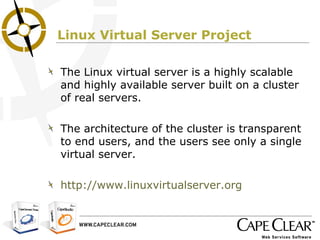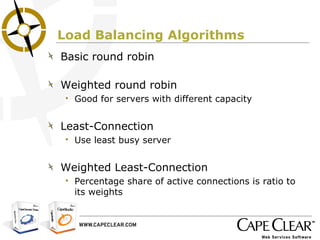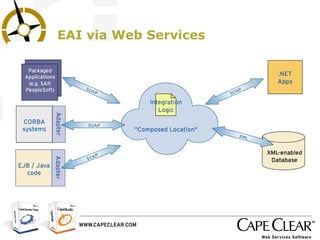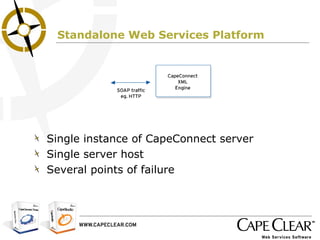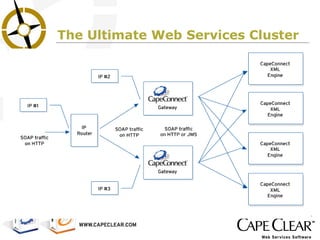Server Farms and XML Web Services
- 1. Jorgen Thelin, CapeConnect Chief Architect PJ Murray, Product Manager Cape Clear Software Server Farms and XML Web Services LinuxWorld Conference & Expo
- 2. Objectives What aspects must a developer be aware of when a Web Services will be run in clustered environment such as a server farm? Do Web Services implementations need to be "cluster aware", or can this be handled transparently by the runtime platform? We revisit the subject of why keeping Web Services implementations as stateless as possible really helps in these circumstances, and the effect of using session-based facilities on scalability.
- 3. Basic Definitions Server Farms are loosely coupled clusters of hardware , networks , and software Web Services are software components with a well defined XML interface that can be incorporated in a distributed application – Based on Standards
- 4. Why cluster? High Availability Transparent backup and failover, redundancy of systems Cheaper than tightly coupled multiprocessor system Parallel processing/Performance E.g. Beowulf Server Integration Different servers perform different tasks For example, WAS – Web Application Server
- 5. Why cluster? Scalability More scalable than multiprocessor systems Capacity on demand possible Automated cross-platform system management Failover and back-up Load Balancing E.g. Linux Virtual Server project
- 6. Determining Requirements Downtime has a cost Typically expressed as a cost per hour Makes it easy to calculate ROI on clustering projects Reduces other costs – disaster recovery Five 9s Currently considered the industry standard for highly-available distributed systems Means less than 6 minutes of annual downtime
- 7. What are critical factors? Size: CPU speed, memory speed, memory size, cache size, disk speed, disk size, network bandwidth? Too many interdependent factors Benchmark, find bottleneck, fix it. Repeat. For Web Services, the bottleneck is usually the network rather than the CPU Many general guidelines: dual CPU machines scales better – application runs uninterrupted on one CPU while the other CPU handles all network interrupts
- 8. Linux Virtual Server Project The Linux virtual server is a highly scalable and highly available server built on a cluster of real servers. The architecture of the cluster is transparent to end users, and the users see only a single virtual server. http://www.linuxvirtualserver.org
- 10. Load Balancing Algorithms Basic round robin Weighted round robin Good for servers with different capacity Least-Connection Use least busy server Weighted Least-Connection Percentage share of active connections is ratio to its weights
- 11. Web Services Defined (Again) Self-describing, self-contained modular entities: Platform and language independent Implementation neutral Open standards based Loosely coupled Programmatically connect business processes Typically requiring integration with existing systems
- 12. Web Services Web Services are software components: Defined in WSDL. Remotely accessible via SOAP. Registered in a UDDI.
- 13. WSDL WSDL: The Web Services Description Language. Describes the methods & parameters. Like a “users manual” for the Web Service. Is based on XML.
- 14. SOAP SOAP: The Simple Object Access Protocol. Defines the message contents and processing. Like a “transport” for calling Web Services. Is based on XML and runs on HTTP(S).
- 15. UDDI UDDI: The Universal Discovery, Description, & Integration. Stores Web Services descriptions and endpoints. Like a “Yellow Pages” for Web Services. Ultimately will require advanced DNS type features Round robin endpoint allocation
- 17. Web Services Standards Web Services standards look familiar: WSDL Java interfaces, CORBA IDL SOAP Java RMI, CORBA IIOP UDDI JNDI, CosNaming, CosTrader But they… Abstract Java, CORBA and .NET technologies. Are being added to many packaged applications.
- 18. EAI via Web Services
- 19. Why Clustering and Web Services? On the back-end (producer) Expose - business logic Integrate - lightweight EAI – technology integration On the front-end (consumer) “ Single Point of Access” for disparate client types HTTP-enabled client interfaces Inter-application communication interface Process inbound XML Private Directory Systems (UDDI)
- 20. Standalone Web Services Platform Single instance of CapeConnect server Single server host Several points of failure
- 21. Web Services Platform with clustering IP router
- 22. CapeConnect + IP Router Multiple CapeConnect server instances Multiple Linux server hosts Router provides single endpoint IP address to the outside world Each server instance runs on a host with its own IP address
- 23. CapeConnect + IP Router Router provides failover among server hosts Router can provide load balancing among server hosts BUT - requires completely stateless Web Services Router is the only single point of failure
- 24. A Web Services Gateway Application level message router Receives and forwards SOAP messages across network topology boundaries Can be used to bridge between different transport schemes For example: HTTP in, JMS out Usually placed in the DMZ for securely connecting Internet SOAP traffic into a corporate network Provides a very convenient place to build clustering and failover into the service hosting architecture for Web Services Also allows load balancing to be used across a cluster of Web Services platforms, thereby avoiding operational hotspots.
- 25. Web Services Platform with Web Services Gateway
- 26. CapeConnect + Gateway Functionally equivalent to using a Clustering IP Router Allows use of other transport types such as JMS between the Gateway and XML Engines Some processing (such as security checks) can be handled by the Gateway
- 27. Gateway can provide “application failover” facilities such as when upgrading a service If the web services are not stateless, some state data needs to be shared between XML Engine instances – either by the middleware or application itself Gateway still provides a single point of failure CapeConnect + Gateway
- 28. The Ultimate Web Services Cluster
- 29. The Ultimate Web Services Cluster Only single point of failure is the IP router which are generally very reliable CapeConnect Gateway makes “cluster management” tasks such as service upgrades easier due to the application level failover facilities
- 30. Any number of CapeConnect XML Engines can be deployed to handle the required service load Two Gateway instances should be sufficient to handle most scenarios, but more can be added if required The Ultimate Web Services Cluster
- 31. Service Development Considerations Issues that Web Service developers need to consider for making their applications “cluster friendly”
- 32. The Need for Stateless Services The stateful-ness of a Web Services implementation is the main determinant of the ease of deployment into a cluster environment Stateless services deliver the maximum performance as there are no additional “overheads” on each call
- 33. Stateless Service Architectures If service components are completely stateless: a wide range of configuration options can be used to create a completely fault tolerant deployment architecture Scalability can be increased by simply adding more processing nodes Service processors can easily be moved from node to node for load balancing purposes
- 34. Stateful Service Architectures If service components are stateful: Failover has to be explicitly handled by either the service or the server hosting the service Load balancing incurs a cost as service instance state needs to be reconstructed on the new node Service applications have to be “cluster aware” to ensure any relevant state information is preserved in persisted data after each request Preserving state information will add an overhead to all calls, which will ultimately reduce performance (response time and scalability)
- 35. Service Instance configuration Any configuration information required by the Web Services needs to be available to all nodes the service is deployed onto To use a single set of config data for all instances, needs to be stored in: Config file on a shared file system drive accessible from all nodes Database accessible to all nodes The Web Services will still need to be deployed into each node in the cluster
- 36. Service Upgrades One of the hardest part of managing a cluster / server farm is how to perform upgrades on individual applications Upgrade each processing node in the cluster in turn (see next slide) Requires “application level” router such as CapeConnect Gateway (IP Routers can’t handle this)
- 37. How To Handle Service Upgrades General approach is: For each processing node in the cluster: Disable an application on one processing node at a time CapeConnect Gateway will route requests for that application to other nodes in the cluster Redeploy the application on the “offline” node Other applications on the ”offline” node can still be active – only the application being upgraded is actually unavailable Bring the new application version back on line Gateway will start routing requests to that node again Proceed with the next node in the cluster until all service instances have been upgraded
- 38. Sessions Any use of “sessions” makes service invocations stateful Requests need to be routed to the same processor node as the previous requests in this session – “affinity”. Or, session state will need to be reconstructed if a request is sent to a different processing node from the last request in this session Load balancing algorithm needs to be session aware – often referred to as “sticky sessions” or “session affinity”
- 39. Conclusions The main aspect Web Services developers need to consider is the stateless-ness of their services Many deployment options are available for creating Web Services clusters Stateless services can be scaled more easily simply by adding more processing nodes Stateless services deliver higher performance
Editor's Notes
- #2: Who am I & Who are CapeClear ? Bio: A Principal Engineer for CapeClear Software. I have had a leading technical role in development of CapeClear's Web Services platform, CapeConnect and Web Services development environment, CapeStudio. My current role as Web Services consultant includes writing articles on web services, presenting to technical and business audiences and developing web service Proofs of Concept. I presented a session at JavaOne2002 on Composite Web Services. Cape Clear Software ( http://www.capeclear.com/ ) has one focus: creating Web Services technology that reduces the business costs of software development and integration. CapeConnect is a Web Services based platform for enterprise integration that is simple, fast, and cost-effective to deploy and maintain. CapeStudio is an integrated Web Services development environment, simplifying design, development, integration, and deployment of Web Services applications using XML, WSDL, and UDDI. Cape Clear's products link packaged business applications, such as ERP and CRM, and diverse technologies, such as Java, J2EE, CORBA, and Microsoft .NET, across intranets and the Internet. Founded in 1999, Cape Clear is a privately held firm with offices in Dublin, London, California, Colorado and Massachusetts. Any more general or esoteric questions I’ll take at the end or ask me after the session.








